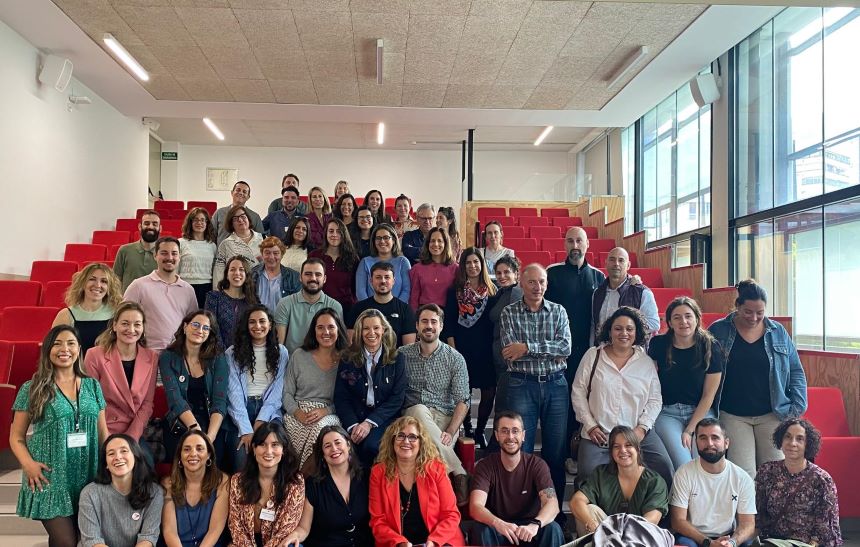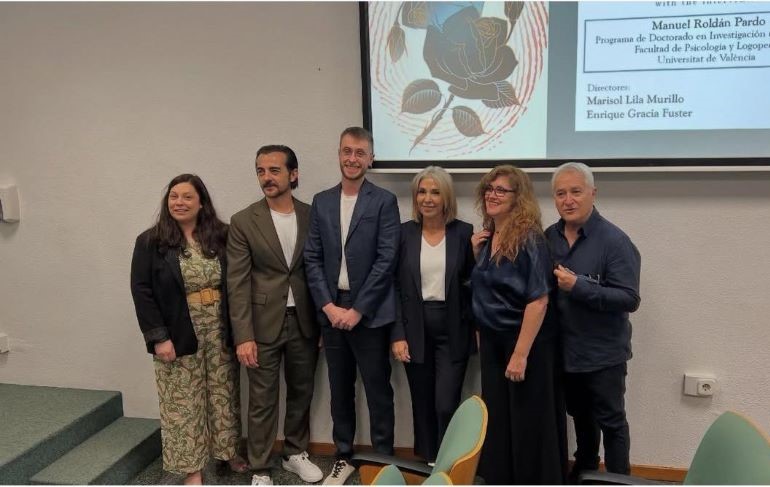From a multidisciplinary approach, in VIO-STRATEGY we conduct research on the biopsychosocial characteristics of intimate partner violence (IPV) perpetrators. The following characteristics of IPV perpetrators are analyzed: neuropsychological and psychophysiological (e.g., cognitive flexibility, attention, hormonal changes, etc.), psychological (e.g., personality traits, empathy, impulsivity, substance abuse, etc.), and social (e.g., social support, immigration, etc.) characteristics.
Biopsychosocial characteristics of intimate partner violence perpetrators
- Expósito-Álvarez, C., Roldán-Pardo, M., Vargas, V., Maeda, M., & Lila, M. (2025). The impact of trauma and substance use on emotion regulation and intimate partner violence perpetration: Implications for perpetrator programs. Behavioral Sciences, 15(2), 156. https://doi.org/10.3390/bs15020156
- Gheorghe, A., Comes-Fayos, J., Mesa-Gresa, P., Moreno, I. R., Lila, M., Romero-Martínez, Á., & Moya-Albiol, L. (2025). Traumatic brain injury effects on neuropsychological measures and recidivism in intimate partner violence against women perpetrators. Psychology of Violence. https://doi.org/10.1037/vio0000621
- Lila, M., Expósito-Álvarez, C., & Roldán-Pardo, M. (2025). Motivational strategies reduce recidivism and enhance treatment adherence in intimate partner violence perpetrators with substance use problems. Frontiers in Psychiatry, 16. https://doi.org/10.3389/fpsyt.2025.1538050
- Roldán-Pardo, M., Santirso, F. A., Tomás, J. M., Gracia, E., & Lila, M. (2025). Development and validation of the Satisfaction with the Intervention for Intimate Partner Violence Perpetrators Scale (SIIPVS). Journal of Family Violence. https://doi.org/10.1007/s10896-025-00804-5
- Romero-Martínez, Á., Lila, M., Sarrate-Costa, C., Comes-Fayos, J., & Moya-Albiol, L. (2025). Suicidal ideation among intimate partner violence perpetrators partly explained by the interaction between borderline traits and both personal distress and impulsivity. Journal Of Family Violence. https://doi.org/10.1007/s10896-025-00860-x
- Sarrate-Costa, C., Lila, M., Moya-Albiol, L., & Romero-Martínez, Á. (2025). Exploring fixation times during emotional decoding in intimate partner violence perpetrators: An eye-tracking pilot study. Brain Sciences, 15(7), 732. https://doi.org/10.3390/brainsci15070732
- Sarrate-Costa, C., Lila, M., Moya-Albiol, L., & Romero-Martínez, Á. (2025). The role of emotional decoding and alcohol misuse in personal distress among intimate partner violence perpetrators. Journal of Aggression, Maltreatment & Trauma, 1–18. https://doi.org/10.1080/10926771.2025.2549745
- Comes‐Fayos, J., Moreno, I. R., Lila, M., Romero‐Martínez, A., & Moya‐Albiol, L. (2024). Weakened sympathetic response and lower parasympathetic activity in intimate partner violence perpetrators when empathizing: Influence of autonomous activation in affective approach and prosocial behavior. Aggressive Behavior, 50(1), e22126. https://doi.org/10.1002/ab.22126
- Comes-Fayos, J., Romero-Martínez, A., Lila, M., Martínez, M., & Moya-Albiol, L. (2024). Low sadness and high happiness facial prevalence to others' suffering in intimate partner violence against women perpetrators: influence of emotional decoding deficits. Current Psychology, 1-14. https://doi.org/10.1007/s12144-024-05976-9
- Moreno, I. R., Comes-Fayos, J., Bressanutti, S., Blasco-Ros, C., Martínez, M., Lila, M., Romero-Martínez, Á., & Moya-Albiol, L. (2024). Unraveling the layers of empathy: Self-Compassion as a partial mediator in male and female offenders’ personal distress and aggression. Journal of Aggression, Maltreatment & Trauma, 1-19. https://doi.org/10.1080/10926771.2024.2313974
- Romero-Martínez, Á., Beser, M., Cerdá-Alberich, L., Aparici, F., Martí-Bonmatí, L., Sarrate-Costa, C., Lila, M., & Moya-Albiol, L. (2024). The role of intimate partner violence perpetrators' resting state functional connectivity in treatment compliance and recidivism. Scientific Reports, 14(1), 2472. https://doi.org/10.1038/s41598-024-52443-3
- Romero-Martínez, Á., Beser-Robles, M., Cerdá-Alberich, L., Aparici, F., Martí-Bonmatí, L., Sarrate-Costa, C., Lila, M., & Moya-Albiol, L. (2024). Executive dysfunction and cortical variations among intimate partner violence perpetrators and the association with sexism. Social Cognitive and Affective Neuroscience, 19(1), nsae046. https://doi.org/10.1093/scan/nsae046
- Romero-Martínez, Á., Beser-Robles, M., Cerdá-Alberich, L., Aparici, F., Martí-Bonmatí, L., Sarrate-Costa, C., Lila, M., & Moya-Albiol, L. (2024). Gray matter volume differences in intimate partner violence perpetrators and its role in explaining dropout and recidivism. Journal of Psychiatric Research, 179, 220-228. https://doi.org/10.1016/j.jpsychires.2024.09.019
- Romero-Martínez, Á., Beser-Robles, M., Cerdá-Alberich, L., Aparici, F., Martí-Bonmatí, L., Sarrate-Costa, C., Lila, M., & Moya-Albiol, L. (2024). The contribution of brain volume to explain autonomous imbalance during recovery from acute stress in batterers. Brain Structure and Function, 229, 797–808. https://doi.org/10.1007/s00429-024-02772-w
- Expósito-Álvarez, C., Santirso, F. A., Gilchrist, G., Gracia, E., & Lila, M. (2023). Participants in court-mandated intervention programs for intimate partner violence perpetrators with substance use problems: A systematic review of specific risk factors. Psychosocial Intervention, 32(2), 89-108. https://doi.org/10.5093/pi2023a7
- Moreno, I. R., Sousa, R., Comes-Fayos, J., Bressanutti, S., Blasco-Ros, C., Rijo, D., Lila, M., Romero-Martínez, A., Moya-Albiol, L. (2023). Diminished vagally mediated heart rate variability in a compassion-eliciting task in intimate partner violence offenders. Journal of Criminal Justice, 87, 102083. https://doi.org/10.1016/j.jcrimjus.2023.102083
- Romero-Martínez, Á., Lila, M., Sarrate-Costa, C., Comes-Fayos, J., & Moya-Albiol, L. (2023). Neuropsychological performance, substance misuse, and recidivism in intimate partner violence perpetrators. Psychosocial Intervention, 32(2), 69-77. https://doi.org/10.5093/pi2022a7
- Romero-Martínez, Á., Lila, M., Sarrate-Costa, C., Comes-Fayos, J., & Moya-Albiol, L. (2023). The interaction between attention deficit hyperactivity disorder and neuropsychological deficits for explaining dropout and recidivism of intimate partner violence perpetrators. European Journal of Psychology Applied to Legal Context, 15(1), 33-42. https://doi.org/10.5093/ejpalc2023a4
- Romero‐Martínez, Á., Lila, M., Sarrate‐Costa, C., Comes‐Fayos, J., & Moya‐Albiol, L. (2023). Dropout and recidivism are partly explained by emotional decoding and perspective taking deficits of intimate partner violence perpetrators. Aggressive Behavior, 49(3), 222-235. https://doi.org/10.1002/ab.22064
- Sarrate-Costa, C., Lila, M., Comes-Fayos, J., Moya-Albiol, L., & Romero-Martínez, Á. (2023). Reduced vagal tone in intimate partner violence perpetrators is partly explained by anger rumination. Current Psychology, 42(33), 29603-29615. https://doi.org/10.1007/s12144-022-03994-z
- Sarrate-Costa, C., Lila, M., Moya-Albiol, L., & Romero-Martínez, Á. (2023). Psychopathic traits partly explained the reduced vagal tone of batterers coping with acute stress. Journal of Aggression, Maltreatment & Trauma, 1-18. https://doi.org/10.1080/10926771.2023.2294917
- Comes-Fayos, J., Blanco-Gandía, M., Moreno, I., Rodríguez-Arias, M., Lila, M., Sarrate-Costa, C., Romero-Martínez, A., & Moya-Albiol, L. (2022). Reduced salivary oxytocin after an empathic induction task in intimate partner violence perpetrators: Importance of socio-affective functions and its impact on prosocial behavior. Psychoneuroendocrinology, 137, 105644. https://doi.org/10.1016/j.psyneuen.2021.105644
- Comes-Fayos, J., Romero-Martínez, Á., Rodríguez Moreno, I., Blanco-Gandía, M. C., Rodríguez-Arias, M., Lila, M., Blasco-Ros, C., Bressutti, S., & Moya-Albiol, L. (2022). Hormonal profile in response to an empathic induction task in perpetrators of intimate partner violence: oxytocin/testosterone ratio and social cognition. International Journal of Environmental Research and Public Health, 19(13), 7897. https://doi.org/10.3390/ijerph19137897
- Martín-Fernández, M., Gracia, E., & Lila, M. (2022). Measuring perceived severity of intimate partner violence against women (IPVAW) among the general population and IPVAW offenders. Psychosocial Intervention, 31(2), 109-119. https://doi.org/10.5093/pi2022a8
- Meij, L., Pulopulos, M., Hidalgo, V., Almela, M., Lila, M., Roney, J., & Salvador, A. (2022). Hormonal changes of intimate partner violence perpetrators in response to brief social contact with women. Aggressive Behavior, 48, 30-39. https://doi.org/10.1002/ab.21995
- Romero-Martínez, A., Lila, M., & Moya-Albiol, L. (2022). Sympathetic nervous system predominance in intimate partner violence perpetrators after coping with acute stress. Journal of Interpersonal Violence, 37(11-12), 10148-10169. https://doi.org/10.1177/0886260520985494
- Romero-Martínez, Á., Santirso, F., Lila, M., Comes-Fayos, J., & Moya-Albiol, L. (2022). Cognitive flexibility and reaction time improvements after cognitive training designed for men perpetrators of intimate partner violence: Results of a pilot randomized controlled trial. Journal of Family Violence, 37(3), 461-473. https://doi.org/10.1007/s10896-021-00304-2
- Expósito-Álvarez, C., Lila, M., Gracia, E., & Martín-Fernández, M. (2021). Risk factors and treatment needs of batterer intervention program participants with substance abuse problems. The European Journal of Psychology Applied to Legal Context, 13(2), 87-97. https://doi.org/10.5093/ejpalc2021a9
- Romero-Martínez, Á., Blanco-Gandía, M., Rodriguez-Arias, M., Lila, M., & Moya-Albiol, L., (2021). Hormonal differences in intimate partner violence perpetrators when they cope with acute stress: A pilot study. International Journal of Environmental Research and Public Health, 18(11), 5831. https://doi.org/10.3390/ijerph18115831
- Romero-Martínez, A., Lila, M., Gracia, E., Martín-Fernández, M., & Moya-Albiol, L. (2021). Generally antisocial batterers with high neuropsychological deficits present lower treatment compliance and higher recidivism. Psychology of Violence 11(3), 318-328. https://doi.org/10.1037/vio0000296
- Romero-Martínez, A., Lila, M., Victoria-Estruch, S., & Moya-Albiol, L. (2021). Can attention and working memory impairments of intimate partner perpetrators explain their risky decision making? Journal of Interpersonal Violence, 36(11-12), 6492–6507. https://doi.org/10.1177/0886260518814263
- Romero-Martínez, Lila, M., & Moya-Albiol, L. (2021). Alexithymic traits are closely related to impulsivity and cognitive and empathic dysfunctions in intimate partner violence perpetrators: New targets for intervention. Applied Neuropsychology: Adult, 28(1), 71-79. https://doi.org/10.1080/23279095.2019.1594233
- Gracia, E., Rodríguez, C. M., Martín-Fernández, M., & Lila, M. (2020). Acceptability of family violence: Underlying ties between intimate partner violence and child abuse. Journal of Interpersonal Violence 35(17-18), 3217-3236. https://doi.org/10.1177/0886260517707310
- Lila, M., Gracia, E., & Catalá-Miñana, A. (2020). More likely to dropout, but what if they don’t? Partner violence offenders with alcohol abuse problems completing batterer intervention programs. Journal of Interpersonal Violence 35(9-10), 1958–1981. https://doi.org/10.1177/0886260517699952
- Romero-Martínez, A., Lila, M., & Moya-Albiol, L. (2020). Alexithymia as a predictor of arousal and affect dysregulations when batterers with attention deficit hyperactivity disorder cope with acute stress. Behavioral Science 10(4), 70. https://doi.org/10.3390/bs10040070
- Vargas, V., Conchell, R., Expósito, C., & Lila, M. (2020). Differences between Latin American and Spanish men in a batterer intervention programme: Proximal and final outcomes. Anales de Psicología 36(3), 418-426. https://doi.org/10.6018/analesps.428831
- Romero-Martínez, A., Lila, M., & Moya-Albiol, L. (2019). Long-term drug misuse increases the risk of cognitive dysfunctions in intimate partner violence perpetrators: Key intervention targets for reducing dropout and reoffending. International Journal of Environmental Research and Public Health, 16(20), 3792. https://doi.org/10.3390/ijerph16203792
- Romero-Martínez, A., Lila, M., & Moya-Albiol, L. (2019). The importance of impulsivity and attention switching deficits in perpetrators convicted for intimate partner violence. Aggressive Behavior, 45(2), 129-138. https://doi.org/10.1002/ab.21802
- Romero-Martínez, A., Lila, M., & Moya-Albiol, L. (2019). The importance of considering alexithymia during initial stages of intimate partner violence interventions to design adjuvant treatments. International Journal of Environmental Research and Public Health, 16(19), 3695. https://doi.org/10.3390/ijerph16193695
- Romero-Martínez, A., Lila, M., Gracia, E., Rodríguez, C. M., & Moya-Albiol, L. (2019). Acceptability of intimate partner violence among male offenders: The role of set-shifting and emotion decoding dysfunctions as cognitive risk factors. International Journal of Environmental Research and Public Health, 16(9), 1537. https://doi.org/10.3390/ijerph16091537
- Martín-Fernández, M., Gracia, E., Marco, M., Vargas, V., Santirso, F. A., & Lila, M. (2018). Measuring acceptability of intimate partner violence against women: Development and validation of the A-IPVAW Scale. The European Journal of Psychology Applied to Legal Context, 10(1), 26-24. https://doi.org/10.5093/ejpalc2018a3
- Vitoria-Estruch, S., Romero-Martínez, A., Lila, M., & Moya-Albiol, L. (2018). Could alcohol abuse drive intimate partner violence perpetrators’ psychophysiological response to acute stress? International Journal of Environmental Research and Public Health, 15(12), 2729. https://doi.org/10.3390/ijerph15122729
- Vitoria-Estruch, S., Romero-Martínez, A., Lila, M., & Moya-Albiol, L. (2018). Differential cognitive profiles of intimate partner violence perpetrators based on alcohol consumption. Alcohol, 70, 61-71. https://doi.org/10.1016/j.alcohol.2018.01.006
- Carbajosa, P., Catalá-Miñana, A., Lila, M., & Gracia, E. (2017). Differences in treatment adherence, program completion and recidivism among batterer subtypes. The European Journal of Psychology Applied to Legal Context, 9(2), 93-101. https://doi.org/10.1016/j.ejpal.2017.04.001
- Carbajosa, P., Catalá-Miñana, A., Lila, M., Gracia, E., & Boira, S. (2017). Responsive versus treatment-resistant perpetrators in batterer intervention programs: Personal characteristics and stages of change. Psychiatry, Psychology and Law, 24(6), 936-950. https://doi.org/10.1080/13218719.2017.1347933
- Catalá-Miñana, A., Lila, M., Oliver, A., Vivo, J. M., Galiana, L., & Gracia, E. (2017). Contextual factors related to alcohol abuse among intimate partner violence offenders. Substance Use & Misuse, 52(3), 294-302. https://doi.org/10.1080/10826084.2016.1225097
- Romero-Martínez, A., Lila, M., & Moya-Albiol, L. (2017). The 2D:4D ratio as a predictor of the risk of recidivism after a court-mandated intervention program for intimate partner violence perpetrators. Journal of Forensic Sciences, 62(3), 705-709. https://doi.org/10.1111/1556-4029.13315
- Vargas, V., Lila, M., Catalá-Miñana, A., & Gracia, E. (2017). Spanish and Latin-American immigrants intimate partner violence offenders: is there a differential profile? Revista de Acción Psicológica, 14(2), 51-68. https://doi.org/10.5944/ap.14.2.20753
- Vitoria-Estruch, S., Romero-Martínez, A., Ruiz-Robledillo, N., Sariñana-González, P., Lila, M., & Moya-Albiol, L. (2017). The role of mental rigidity and alcohol consumption interaction on intimate partner violence: A Spanish study. Journal of Aggression Maltreatment & Trauma, 26(6), 664-675. https://doi.org/10.1080/10926771.2017.1300619
- Lila, M., Gracia, E., Catalá-Miñana, A., & Santirso, F. A. (2016). El consumo abusivo de alcohol en inmigrantes latinoamericanos que participan en programas de intervención para maltratadores: importancia de la adherencia al tratamiento. Universitas Psychologica, 15(4). https://doi.org/10.11144/Javeriana.upsy15-4.caai
- Rodriguez, C. M., Gracia, E., & Lila, M.A (2016). Multimethod prediction of child abuse risk in at-risk simple of male intimate partner violence offenders. Child Abuse & Neglect, 60, 27-35. https://doi.org/10.1016/j.chiabu.2016.09.006
- Romero-Martínez, A., Lila, M., & Moya-Albiol, L. (2016). Testosterone and attention deficits as possible mechanisms underlying impaired emotion recognition in intimate partner violence perpetrators. European Journal of Psychology Applied to Legal Context, 8, 57-62. https://doi.org/10.1016/j.ejpal.2016.01.001
- Romero-Martínez, A., Lila, M., & Moya-Albiol, L. (2016). The testosterone/cortisol ratio moderates the proneness to anger expression in antisocial and borderline intimate partner violence perpetrators. The Journal of Forensic Psychiatry & Psychology, 27, 135-144. https://doi.org/10.1080/14789949.2015.1096415
- Romero-Martínez, A., Lila, M., Vitoria-Estruch, S., & Moya-Albiol, L. (2016). High immunoglobulin A levels mediate the association between high anger expression and low somatic symptoms in intimate partner violence perpetrators. Journal of Interpersonal Violence, 31, 732-742. https://doi.org/10.1177/0886260514556107
- Gracia, E., Rodriguez, C. M., & Lila, M. (2015). Preliminary evaluation of an analog procedure to assess acceptability of intimate partner violence against women: The Partner Violence Acceptability Movie Task. Frontiers In Psychology, 6, 1567. https://doi.org/10.3389/fpsyg.2015.01567
- Romero-Martínez, A., Lila, M., & Moya-Albiol, L. (2015). Alcohol abuse mediates the association between baseline T/C ratio and anger expression in intimate partner violence perpetrators. Behavioral Sciences, 5, 113-120. https://doi.org/10.3390/bs5010113
- Romero-Martínez, A., Lila, M., & Moya-Albiol, L. (2015). Empathy impairments in antisocial and borderline intimate partner violence perpetrators: A key factor for recidivisms risk. Violence and Victims, 31(2), 347-360. https://doi.org/10.1891/0886-6708.VV-D-14-00149
- Vargas, V., Lila, M., & Catalá-Miñana, A. (2015). ¿Influyen las diferencias culturales en los resultados de los programas de intervención con maltratadores? Un estudio con agresores españoles y latinoamericanos. Psychosocial Intervention, 24, 41-47. https://doi.org/10.1016/j.psi.2015.03.001
- Catalá-Miñana, A., Walker, K., Bowen, E., & Lila, M. (2014). Cultural differences in personality and aggressive behavior in Intimate partner violence offenders: A comparison of English and Spanish offenders. Journal of Interpersonal Violence, 29, 2652-2669. https://doi.org/10.1177/0886260513517301
- Lila, M., Oliver, A., Catalá-Miñana, A., Galiana, L., & Gracia, E. (2014). The intimate partner violence responsibility attribution scale (IPVRAS). European Journal of Psychology Applied to Legal Context, 6, 29-36. https://doi.org/10.5093/ejpalc2014a4
- Romero-Martínez, A., Lila, M., & Moya-Albiol, L. (2014). El perfil del maltratador machista: ¿Qué nos dice su biología? Mètode, 82, 22-27. https://metode.cat/wp-content/uploads/2014/07/82CA_maltractador_masclista.pdf
- Romero-Martínez, A., Lila, M., Conchell, R., González-Bono, E., & Moya-Albiol, L. (2014). Immunoglobulin A response to acute stress in intimate partner violence perpetrators: The role of anger expression-out and testosterone. Biological Psychology, 96, 66-71. https://doi.org/10.1016/j.biopsycho.2013.11.009
- Romero-Martínez, A., Lila, M., Vitoria-Estruch, S., & Moya-Albiol, L. (2014). Mini review: Psychosocial stress such as violence against their partners could benefit general immunity in intimate partner violence perpetrators. International Journal of Emergency Mental Health and Human Resilience, 16, 104-107.
- Romero-Martínez, A., Nunes-Costa, R., Lila, M., González-Bono, E., & Moya-Albiol, L. (2014). Cardiovascular reactivity to a marital conflict version of the Trier Social Stress Test in intimate partner violence perpetrators. Stress-The International Journal on the Biology of Stress, 17, 321-327. https://doi.org/10.3109/10253890.2014.919448
- Catalá-Miñana, A., Lila, M., & Oliver, A. (2013). Consumo de alcohol en hombres penados por violencia contra la pareja: Factores individuales y contextuales. Adicciones, 25, 19-28. https://doi.org/10.20882/adicciones.68
- Lila, M., Gracia, E., & Murgui, S. (2013). Psychological adjustment and victim-blaming among intimate partner violence offenders: The role of social support and stressful life events. European Journal of Psychology Applied to Legal Context, 5, 147-153. https://doi.org/10.5093/ejpalc2013a4
- Romero-Martínez, A., González-Bono, E., Lila, M., & Moya-Albiol, L. (2013). Testosterone/cortisol ratio in response to acute stress: A possible marker of risk for marital violence. Social Neuroscience, 8, 240-247. https://doi.org/10.1080/17470919.2013.772072
- Romero-Martínez, A., Lila, M., Catalá-Miñana, A., Williams, R. K., & Moya-Albiol, L. (2013). The contribution of childhood parental rejection and early androgen exposure to impairments in socio-cognitive skills in intimate partner violence perpetrators with high alcohol consumption. International Journal of Environmental Research and Public Health, 10, 3753-3770. https://doi.org/10.3390/ijerph10083753
- Romero-Martínez, A., Lila, M., Sariñana-González, P., González-Bono, E., & Moya-Albiol, L. (2013). High testosterone levels and sensitivity to acute stress in perpetrators of domestic violence with low cognitive flexibility and impairments in their emotional decoding process: A preliminary study. Aggressive Behavior, 39, 355-369. https://doi.org/10.1002/ab.21490
- Romero-Martínez, A., Lila, M., Williams, R. K., González-Bono, E., & Moya-Albiol, L. (2013). Skin conductance rises in preparation and recovery to psychosocial stress and its relationship with impulsivity and testosterone in intimate partner violence perpetrators. International Journal of Psychophysiology, 90, 329-333. https://doi.org/10.1016/j.ijpsycho.2013.10.003
- Lila, M., Gracia, E., & Herrero, J. (2012). Asunción de responsabilidad en hombres maltratadores: Influencia de la autoestima, la personalidad narcisista y la personalidad antisocial. Revista Latinoamericana de Psicología, 44, 99-108. https://core.ac.uk/download/pdf/229321709.pdf
- Lila, M., Gracia, E., & Herrero, J. (2011). Domestic violence against women: Exploring attributions of responsibility among male offenders. En E. Kourkoutas y F. Erkman (eds.), Interpersonal acceptance and rejection. Social, emocional and educational contexts. Brown Walker Press
- Catalá, A., Lila, M., Conchell, R., & Lorenzo, M. V. (2010). ¿Cómo ocurrieron los hechos? Descripción de variables situacionales y contextuales implicadas en casos de violencia doméstica contra la mujer. En F. Expósito, M. C. Herrera, G. Buela, M. Novo y F. Fariña (Eds.), Psicología Jurídica. Áreas de Investigación (pp. 41-51). Xunta de Galicia.
- Lila, M., Herrero, J., & Gracia, E. (2008). Atribución de responsabilidad y minimización en hombres penados por violencia contra la mujer: Un instrumento de evaluación. En F. J. Rodríguez, C. Bringas, F. Fariña, R. Arce y A. Bernardo (Eds.), Psicología jurídica. Familia y victimología. Ediciones de la Universidad de Oviedo.











